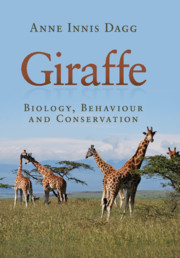Book contents
- Frontmatter
- Dedication
- Contents
- Preface
- Acknowledgements
- List of abbreviations
- 1 Time-line of giraffe
- 2 The giraffe’s environment
- 3 Feeding in the wild
- 4 Social behaviour and populations
- 5 Individual behaviours
- 6 External features
- 7 Anatomy
- 8 Physiology
- 9 Pregnancy, growth, reproduction and aging
- 10 Giraffe in zoos
- 11 Status and conservation of giraffe races
- Appendix Parasites and pathogens
- References
- Index
7 - Anatomy
Published online by Cambridge University Press: 05 February 2014
- Frontmatter
- Dedication
- Contents
- Preface
- Acknowledgements
- List of abbreviations
- 1 Time-line of giraffe
- 2 The giraffe’s environment
- 3 Feeding in the wild
- 4 Social behaviour and populations
- 5 Individual behaviours
- 6 External features
- 7 Anatomy
- 8 Physiology
- 9 Pregnancy, growth, reproduction and aging
- 10 Giraffe in zoos
- 11 Status and conservation of giraffe races
- Appendix Parasites and pathogens
- References
- Index
Summary
Giraffe are big. All races have similar measurements, with adult males in the wild up to 5.5 m tall and adult females about 4.3 m (Bush, 2003). Taller specimens have been reported by hunters who have shot them, but their calculations may reflect a bit of wishful thinking. Giraffe in zoos are usually somewhat shorter, presumably because of their unnatural living conditions. Adult males in the wild weigh from 850 to 1950 kg, while females weigh from 700 to 1200 kg (Bush, 2003); an average weight for males is generally considered to be 1200 kg and for females 800 kg.
When creatures as strange-looking as giraffe were first brought to Europe, men with a scientific bent began to describe them and their internal organs for academic journals. The giraffe’s long neck and legs especially have interested anatomists for over 170 years, with Richard Owen publishing anatomical data on the Nubian giraffe as early as 1841.
Many organs and systems of the giraffe have been described in detail in the literature, as this chapter indicates, but others have not. There may therefore be an imbalance in what is discussed here, but this cannot be remedied at present.
Colour photographs of a giraffe dissection are given in http://whatsinjohnsfreezer.com/2012/12/02/thank-you-giraffe-anatomy/. They feature jugular vein, nuchal ligament, cross-section of trachea, heart, rib cage, rumen, molar teeth, inner cheek spines, brain, tapetum lucidum of an eye and a misshapen hoof. These organs/areas are marked with an asterisk* in the text.
Information on the amazing circulation and reproduction systems of giraffe, which have attracted the attention of scores of curious scientists, is covered in Chapters 8 and 9.
- Type
- Chapter
- Information
- GiraffeBiology, Behaviour and Conservation, pp. 100 - 116Publisher: Cambridge University PressPrint publication year: 2014

